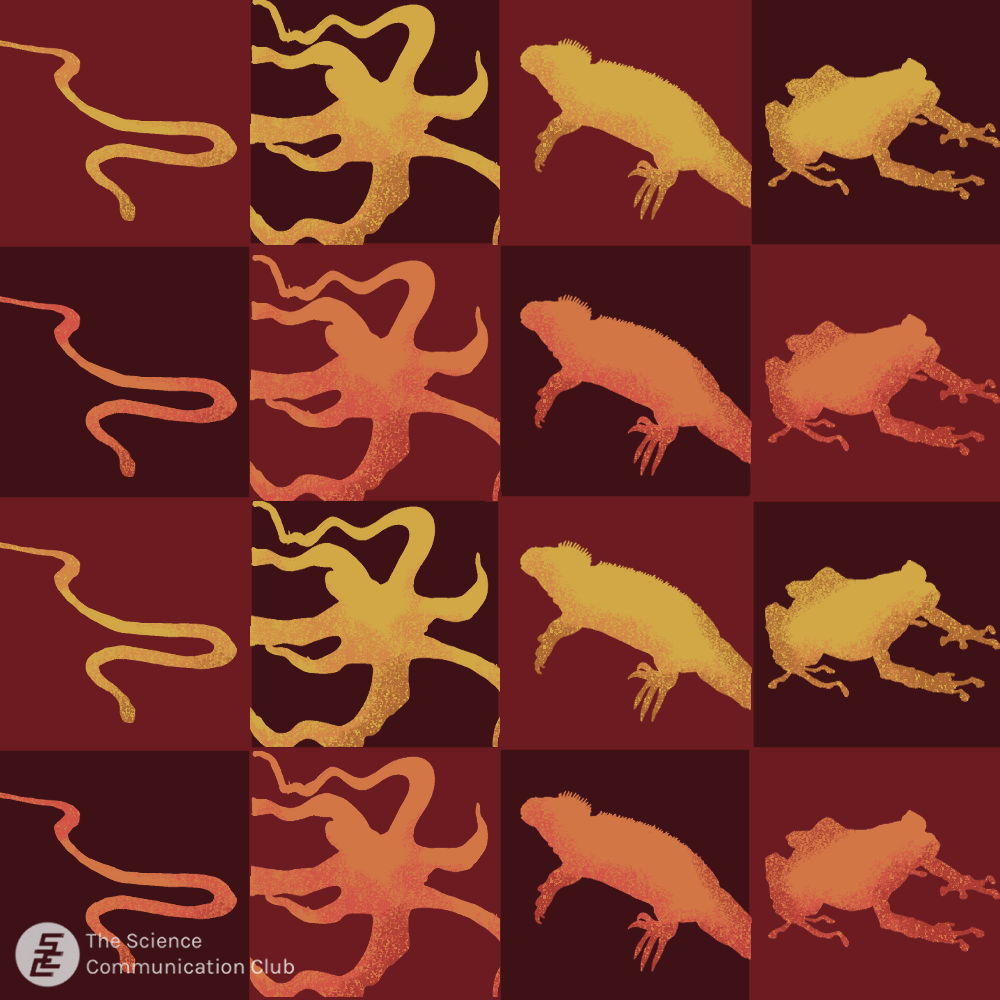
Written by Angie Lo
Illustrated by Yolanda Liu
This article is part of our Special’s Week series, The Science of Science Fiction and Popular Media.
Shapeshifting creatures are amazing, and they’re not just in our favourite books or movies— they’re all around us. Many animals have the ability to change size and shape, allowing them to do things from scaring off predators to unlocking new abilities. Some of them, like the pufferfish, are famous for their ability, but there are other lesser-known shapeshifters that are just as awesome. Here’s a look at some of the lesser-known members of this shapeshifting team—and the ways they perform this fantastic feat.
Flying snakes: shapeshifting for the skies
Flying snakes aren’t like your usual snake: they have the ability to glide through the air, allowing them to jump from trees and other high places and float safely towards their landing spots. Normally, their rounded bodies don’t have this gliding ability, but they’re able to shapeshift their bodies into ones fit for air travel. Splaying its ribs, the flying snake flattens itself to make its body flatter and more triangular1. This allows its body to resemble a wing, creating favourable aerodynamic conditions2.When combining shapeshifting with other techniques such as special movements through the air, the flying snake has everything it needs to soar3.
Marine masters of disguise
If there was an award for the most versatile shapeshifter on Earth, it would go to the mimic octopus. This creature can contort its body to resemble different sea creatures, becoming a sea snake by hiding in a hole, sticking two arms out, and wiggling them to imitate a snake’s movement4. Pulling all its legs backward and flattening its head allows it to turn into a flounder5. In fact, the octopus’ shapeshifting ability is so good that it can turn itself into 15 different animals—and switch between these disguises in a short amount of time. Many of the animals it turns into are either dangerous or icky-tasting, protecting the mimic octopus from a variety of potential predators4.

From tall to small— and back again
The marine iguanas of the Galápagos Archipelago have the ability to shrink—shortening their entire body lengths by up to 20%. This allows them to adapt to instances where it’s harder to find food—specifically red and green algae. During times when these algae become scarce, these iguanas make themselves shorter to use up less resources. Although scientists aren’t yet sure what causes this shrinkage, they speculate that it’s due to iguanas absorbing their own bone matter. This change in size is also reversible: when food becomes more plentiful, these iguanas increase their body lengths once again6.
However, for all their ability, these iguanas face challenges that they can’t fight alone. Non-native animals like cats, dogs, and rats prey upon these creatures, and climate change has the potential to further decrease the availability of their food sources7. Fortunately, conservation efforts are helping to protect the marine iguana7— and with action from the rest of us, the mighty iguana can continue to thrive.
Spikes on demand: meet the team’s new member
In recent years, researchers discovered a brand-new frog that could change its skin texture in a matter of minutes. First picked up in 2009 in a reserve in Ecuador, the frog was closely studied by the researchers, with the findings finally released to the world in a 2015 paper. The frog’s skin can rapidly switch from smooth to spiny, earning it two names: the common name “mutable rainfrog” for its shapeshifting ability, and the nickname “punk rocker frog” for its built-in spiked jacket8.
The researchers haven’t exactly pinpointed how or why the mutable rainfrog gets its spines, but they speculate that it’s caused by water filling up small structures on the skin, and that the spines help the frog with environmental camouflage. They also speculate that this skin-changing trait may be present in other amphibians as well9. If that’s so, it might not be long before even more new members join the team of animal shapeshifters.
Sources
- Holden D, Socha JJ, Cardwell ND, Vlachos PP. Aerodynamics of the flying snake Chrysopelea paradisi: How a bluff body cross-sectional shape contributes to gliding performance. Journal of Experimental Biology. 2014;217(3):382–394. doi:10.1242/jeb.090902
- Socha JJ. Gliding Flight in Chrysopelea: Turning a Snake into a Wing. Integrative and Comparative Biology. 2011;51(6):969–982. doi:10.1093/icb/icr092
- Yeaton IJ, Ross SD, Baumgardner GA, Socha JJ. Undulation enables gliding in flying snakes. Nature Physics. 2020;16:974–982. doi:10.1038/s41567-020-0935-4
- Mimic Octopus. National Geographic. [accessed 2022 Nov 25]. https://www.nationalgeographic.com/animals/invertebrates/facts/mimic-octopus
- Baker B. Unusual adaptations: Evolution of the mimic octopus. BioScience. 2010;60(11):962–962. doi:10.1525/bio.2010.60.11.18
- Wikelski M, Thom C. Marine iguanas shrink to survive El Niño. Nature. 2000;403:37–38. doi:10.1038/47396
- Osterloff E. Marine iguanas: The incredible shrinking lizards of the Galápagos. Natural History Museum. 2020 May 22 [accessed 2022 Nov 25]. https://www.nhm.ac.uk/discover/shrinking-galapagos-marine-iguanas.html
- Arnold C. Shape-shifting frog found, goes from spiky to smooth in minutes. Animals. 2015 Mar 25 [accessed 2022 Nov 25]. https://www.nationalgeographic.com/animals/article/150325-ecuador-new-species-punk-rocker-frog-shape-shifting
- Guayasamin JM, Krynak T, Krynak K, Culebras J, Hutter CR. Phenotypic plasticity raises questions for taxonomically important traits: A remarkable new Andean rainfrog (pristimantis) with the ability to change skin texture. Zoological Journal of the Linnean Society. 2015;173(4):913–928. doi:10.1111/zoj.12222